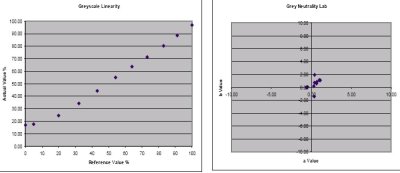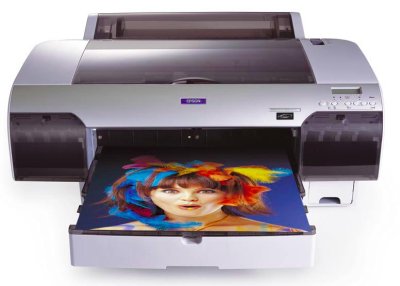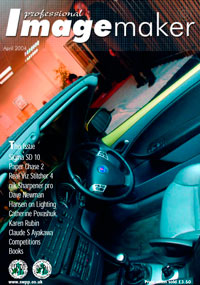articles/Paper/layingtrail-page7
Paper Chase - Laying the Trail - part 7 of 1 2 3 4 5 6 7 8 9 10
by Mike McNamee Published 01/04/2004

One, more specialised, application is the reproduction of fine art. Things can go very awry in this because of metamerism. Let's suppose you are reproducing a gouache painted original. The metamerism of the pigments is going to be quite large. You then take a picture and introduce the metamerism of the camera detector. Then you make a print using pigment inks and stand the print alongside the original, in front of the artist who is likely to be your fussiest client in terms of colour anyway! What is amazing is that the job ever gets done. Sometimes the best you are going to do in these circumstances is to match visually, which is why the people who do this sort of thing for a living tend to charge quite a lot to set up the print for a limited edition run. Once you have agreed on the (compromise) colour of the image you had better make sure your profiling is well bottled down or you will have to go through the rain dance all over again!
The Measuring Kit
ANALYSIS IN ACTION The flesh tone data from the same paper. In a perfect world the pink, Print Values should lie directly above their File Values. Above left are the results from using the Look Up Tables in the Epson printer driver i.e. a set-up that is not optimized for a non-Epson paper. The skin tones are so desiderated that the near neutral skin tones have been pushed through the origin of the graph and into the cyan quadrant. On the right, a result for the same printer, paper and ink but this time with a bespoke profile. Here the flesh tones are just a little desiderated but the hue values are maintained (the data points have moved in a straight line towards the neutral (0, 0) point. The split of the error parameters shows that the Bespoke Profile image had flesh errors averaging 2.65 compared to 9.44 for the poorer image.

For the Bespoke Profile the other errors in the gamut were low, some of the lowest we have produced in fact. An error of 1 is only just detectable by eye.
The error level created by using the wrong profile is fairly typical. Such a print is acceptable as a rough proof but not suitable for sale as a quality item.
What is Paper? Paper is made in truly vast quantities worldwide, Rey and Co, the biggest manufacturer have more than 100,000 people on their staff. The production of paper requires International Paper to plant 500,000,000 tree seedling each year just to keep up. It is estimated that inkjet media alone will run to to 97billion sheets by 2005 - and that's just Western Europe!
While it is something we take for granted, it is also something that many people know little about. It is made from a variety of materials depending on both cost and intended use. Newsprint is made from ground wood pulp and has residual amounts of lignin which make it discolour with time. It has to be fiercely bleached and residual chemicals from this process cause it to disintegrate over long periods of time. Wood based papers are not therefore ideal for imaging making - acid free and rag papers are preferred. These are made from fibres derived from cellulose rather than lignin. The cellulose can come from grasses such as esparto or from cotton. Scrap cloth is often used to make rag paper (hence the name).
The so-called wood free papers are anything but. The wood is very finely ground, heavily bleached and often has whitener added which fluoresces mildly to make the paper whiter than white - the same trick that makes Persil washed clothes whiter than white.
The art papers have a surface coating of china clay to give a smooth, non-absorbent finish. This keeps the inks close to the surface and hence more vibrant. The glossy art papers are made by calendaring the surface with multiple passes through hot (steam heated), high-pressure rollers. Strangely, art papers are not normally used for drawing and painting, they are used for classy art books and magazines with the paper being optimized for ink-on-paper printing. The terminology is now rather old and less used to describe today's papers.
In recent times new materials have made an appearance as "paper". The classic one known to photographers is resin coated paper such as Ilford Multigrade. Here plastic film is bonded each side of a paper carrier material and super coatings are applied to the top surface to hold the "high tech" surface be it an inkjet receptor or a silver halide emulsion. In the same way that resin coated paper requires less washing because of the "barrier" to chemicals provided by the polythene, the same philosophy may be used to prevent ink running away into the base paper in the printing process. Museum curators and fine art collectors are inherently suspicious of resin coatings. Under attack from ultra violet light, the polymer coating is sometimes the first thing to yield.
Please Note:
There is more than one page for this Article.
You are currently on page 7
- Paper Chase - Laying the Trail page 1
- Paper Chase - Laying the Trail page 2
- Paper Chase - Laying the Trail page 3
- Paper Chase - Laying the Trail page 4
- Paper Chase - Laying the Trail page 5
- Paper Chase - Laying the Trail page 6
- Paper Chase - Laying the Trail page 7
- Paper Chase - Laying the Trail page 8
- Paper Chase - Laying the Trail page 9
- Paper Chase - Laying the Trail page 10
1st Published 01/04/2004
last update 09/12/2022 14:55:40
More Paper Articles
There are 0 days to get ready for The Society of Photographers Convention and Trade Show at The Novotel London West, Hammersmith ...
which starts on Wednesday 15th January 2025





